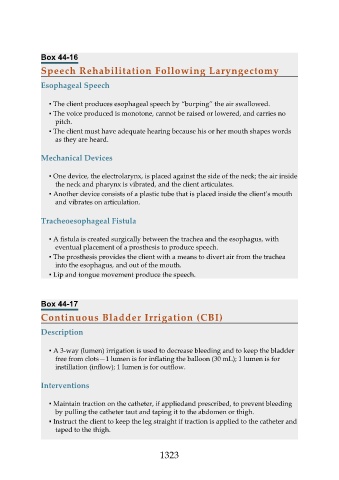Page 1323 - Saunders Comprehensive Review For NCLEX-RN
P. 1323
Box 44-16
Speech Rehabilitation Following Laryngectomy
Esophageal Speech
▪ The client produces esophageal speech by “burping” the air swallowed.
▪ The voice produced is monotone, cannot be raised or lowered, and carries no
pitch.
▪ The client must have adequate hearing because his or her mouth shapes words
as they are heard.
Mechanical Devices
▪ One device, the electrolarynx, is placed against the side of the neck; the air inside
the neck and pharynx is vibrated, and the client articulates.
▪ Another device consists of a plastic tube that is placed inside the client’s mouth
and vibrates on articulation.
Tracheoesophageal Fistula
▪ A fistula is created surgically between the trachea and the esophagus, with
eventual placement of a prosthesis to produce speech.
▪ The prosthesis provides the client with a means to divert air from the trachea
into the esophagus, and out of the mouth.
▪ Lip and tongue movement produce the speech.
Box 44-17
Continuous Bladder Irrigation (CBI)
Description
▪ A 3-way (lumen) irrigation is used to decrease bleeding and to keep the bladder
free from clots—1 lumen is for inflating the balloon (30 mL); 1 lumen is for
instillation (inflow); 1 lumen is for outflow.
Interventions
▪ Maintain traction on the catheter, if appliedand prescribed, to prevent bleeding
by pulling the catheter taut and taping it to the abdomen or thigh.
▪ Instruct the client to keep the leg straight if traction is applied to the catheter and
taped to the thigh.
1323

